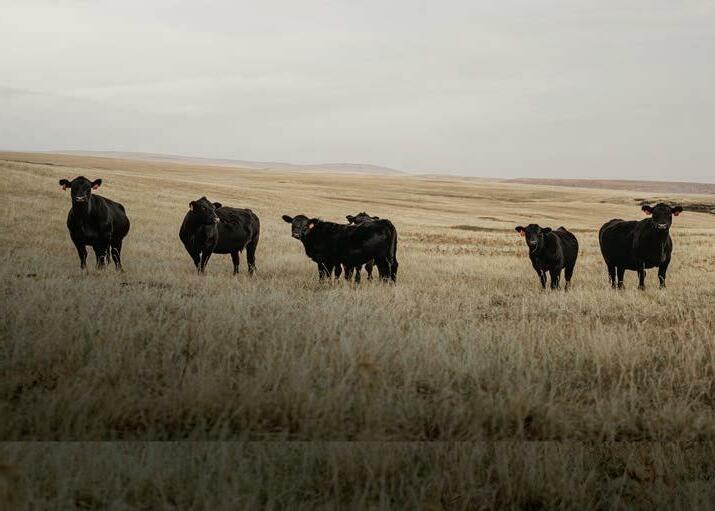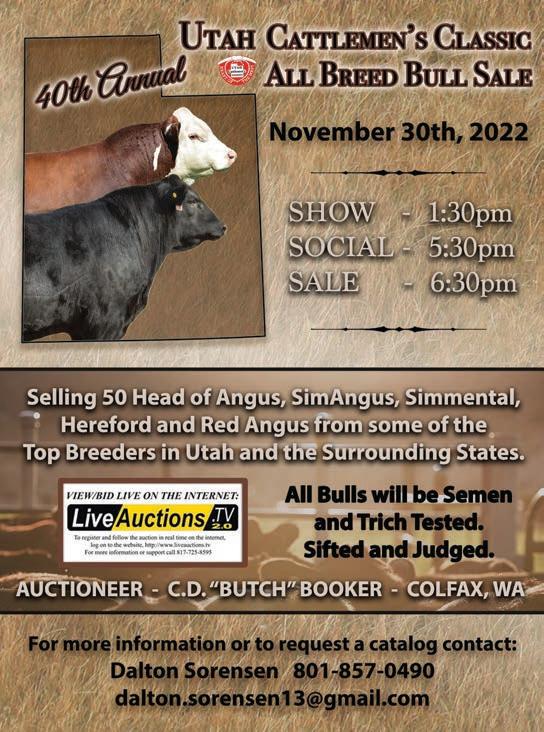
7 minute read
U of I: Selection Priorities and Tools for Evaluation and Improvement
Selection Priorities and Tools for Evaluation and Improvement
J. BENTON GLAZE, JR., PH.D. Extension Beef Cattle Specialist Department of Animal & Veterinary Science University of Idaho
Advertisement
Beef cattle selection is often based on producers’ instincts about the relative value of a wide range of traits including growth, fertility, reproductive efficiency, structural soundness, carcass, calving ease and temperament. Producers should compare animals based on all the relative traits. This process of combining a number of traits into a single breeding decision is considered setting a breeding objective. Breeding objectives should be composed of all traits that affect profit (economically important) and some indication of the relative emphasis each trait should receive. The study cited below provides some insight as to the traits that are perceived important as producers make selection decisions.
In 2019 a survey of cow-calf producers was conducted to gather perspectives on various management strategies and industry challenges. A total of 1,414 responses from beef producers from 44 U.S. states were included in the final study. One component of the study asked producers to prioritize the parameters (traits) used for selecting bulls and replacement females to use in their herds. The prioritization of traits when selecting bulls is presented in Table 1 and the prioritization of traits when selecting replacement females is presented in Table 2. In both tables, the percentages represent an aggregate value of when the traits were deemed either very important or extremely important. In the paragraphs below, a discussion of some of the economically important traits and tools to improve them is provided.
The 2017 National Animal Health Monitoring System (Beef-2017) survey indicated that dystocia was responsible for approximately 25% of all calf losses and approximately 17% beef breeding cattle losses. As producers consider bulls to produce replacement heifers or bulls to use on first-calf heifers, they should make selection decisions that lead to a reduced incidence of dystocia. A couple of tools that producers can use in this selection process are maternal calving ease (MCE) expected progeny differences (EPDs) and calving ease (CE) EPDs. Maternal calving ease (MCE) EPD are expressed as a difference in percentage of unassisted births and predict the difference in ease with which a sire’s daughters will calve as first-calf heifers. Larger values indicate greater calving ease (larger percentage of unassisted births) in a sire’s daughters. In a comparison of two bulls being considered for use to produce replacement heifers, it is noted that Bull #1 has a MCE EPD of +5.5 and Bull #2 has a MCE EPD of +13.5. This suggests that 8% more of Bull #2’s daughters would calve unassisted as first-calf heifers than Bull #1’s daughters. Calving ease (CE) EPD are expressed as a difference in percentage of unassisted births and predict the difference in ease with which a sire’s calves will be born when he is mated to first-calf heifers. Larger values indicate greater calving ease (larger percentage of unassisted births) in first-calf heifers. In a comparison of two bulls considered to be used on first-calf heifers, it is noted that Bull #3 has a CE EPD of +19.0 and Bull #4 has a CE EPD of +6.0. This suggests that Bull #3, when bred to first-calf heifers, would sire 13% more calves that are born unassisted than Bull #4. Reproductive efficiency determines to a great extent the profitability of the beef cattle enterprise. Without live calves on the EVERY RANCHER FEELS THE PAIN OF RISING INPUT COSTS. GET RELIEF WITH A TUB THAT
PAYS FOR ITSELF.
The tub that pays for itself. Sounds to good to be true, huh?
Why not hear it straight from the horse’s mouth? Scan this QR code with your phone camera to listen to frugal ranchers explain how it pays for itself on their family operations!
Join progressive ranchers using the tub that pays for itself. MATT THOMPSON: (208) 589-3185

ground, there are no opportunities to measure other traits and market calves. It is clear, that reproductive traits should receive a great deal of emphasis in selection programs. While there is no single trait/measure to assist producers with improving reproductive efficiency in their herds, following are a few examples of traits/tools that could be considered by producers as they strive to improve reproductive efficiency and longevity.
Heifer pregnancy (HP) EPD are expressed as a difference in percentage of a sire’s daughters conceiving to calve at two years of age. Larger values indicate greater numbers of pregnant heifers. Heifer pregnancy EPD may be used to improve reproductive efficiency in a breeding herd. In a comparison of two bulls being considered for use to produce replacement heifers, it is noted that Bull #5 has a HP EPD of +3.5 and Bull #6 has a HP EPD of +9.5. This suggests that 6% more of Bull #6’s daughters would end up pregnant as two-year-olds than Bull #5’s daughters.
Scrotal circumference (SC) EPD are expressed in centimeters and represent the sire’s ability to transmit scrotal growth to his offspring compared to other sires. Larger values indicate greater scrotal circumferences. Scrotal circumference EPD may be used to improve reproduction in breeding herds through improved semen traits (males) and decreased age of puberty (males and females). In a comparison of two bulls being considered for use in a herd, it is noted that Bull #7 has a SC EPD of +0.4 and Bull #8 has a SC EPD of +1.2. This suggests that Bull #8’s male calves would have scrotal measurements 0.8 centimeters greater than Bull #7’s male calves at a year of age. Stayability (STAY) EPD are expressed as a difference in percentage of a sire’s daughters remaining in the breeding herd until at least six years of age. Larger values indicate greater numbers of cows remaining in the breeding herd for longer periods. Stayability EPD may be used to improve reproductive efficiency and longevity in a breeding herd. In a comparison of two bulls being considered for use in a herd, Bull #9 has a STAY EPD of +11.0 and Bull #10 has a STAY EPD of -3.0. This suggests that 14% of Bull #9’s daughters would remain in the herd until at least six years of age compared to Bull #10’s daughters.
According to the NAHMS Beef-2017 survey, 21.1% of the cows that were removed from herds were culled due to physical unsoundness. In recent years, the American Angus Association has provided claw set and foot angle EPD to assist producers in maintaining and improving the level of physical in beef cattle herds. Claw set is scored on a 9-point scale (1 = splayed, 9 = overlapping), as is foot angle (1 = steep, 9 = shallow). In both cases, a score of 5 is ideal. The target claw set is a hoof with toes that are symmetrical and toes that are evenly and appropriately spaced. The target foot angle is characterized by a 45-degree angle at the pastern joint and a pastern that has appropriate length and heel depth. Recently, only scores of 5 to 9 were being used in the genetic evaluation, so lower scores (EPD) are more favorable. Following are examples of a couple of tools that can be used to improve structural soundness and longevity in beef cattle herds.
Claw set (CLAW) EPD are expressed in units of claw-set scores with lower EPD being more favorable. Consider and compare the following two bulls: Bull #11 has a CLAW EPD of +0.50 and Bull #12 has a CLAW EPD of +1.50. This suggests that Bull #11, when bred to a group of beef females, would sire calves that would be a full score closer to the target.
Foot angle (ANGLE) EPD are expressed in units of foot-angle scores with lower EPD being more favorable. Consider and compare the following two bulls: Bull #13 has an ANGLE EPD of +1.00 and Bull #14 has an ANGLE EPD of +0.50. This suggests that Bull #14, when bred to a group of beef females, would sire calves that would be a half score closer to the target.
Today, beef producers have excellent tools to estimate the genetic worth of animals for various economically important traits, including those related to calving ease, reproduction, and structural soundness. As producers make selection decisions, they should choose animals that have the potential to positively influence the performance for these traits in future offspring. Producers should also make sure that the selection objectives for the traits discussed here are in balance with the selection objectives of other economically important traits (e.g., growth, carcass).








